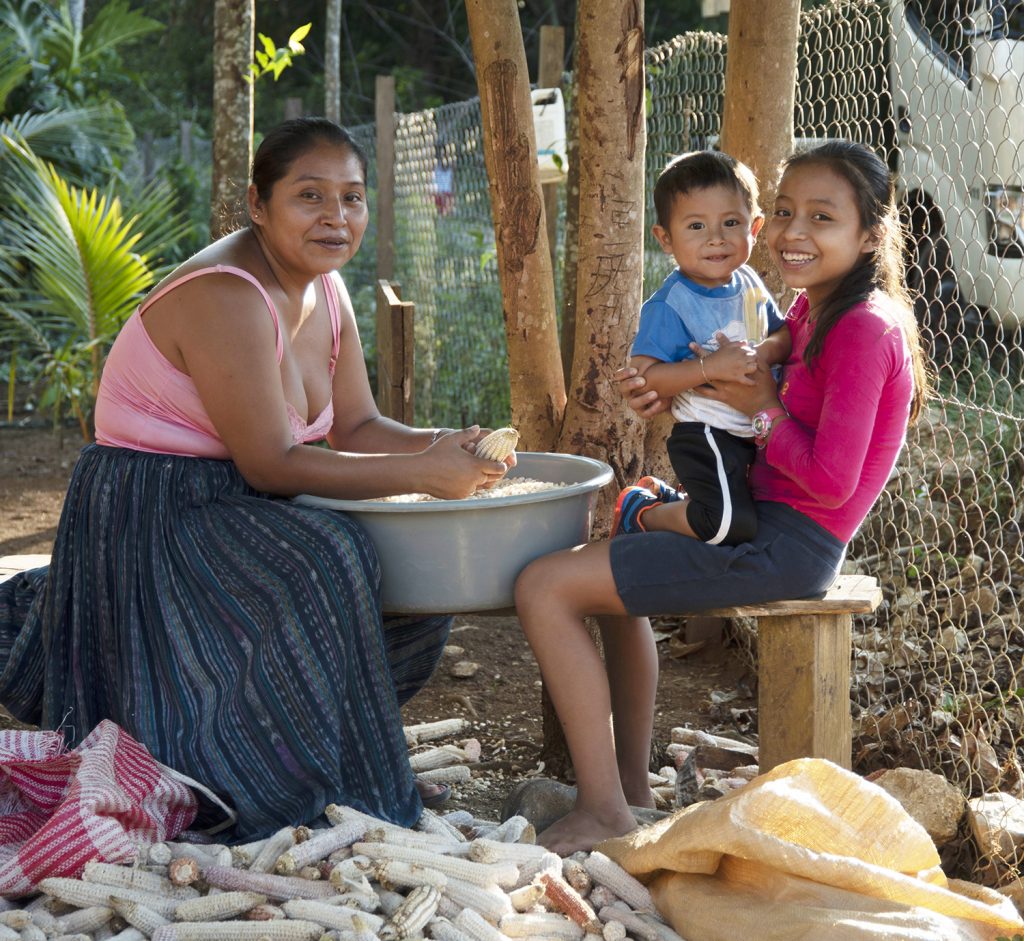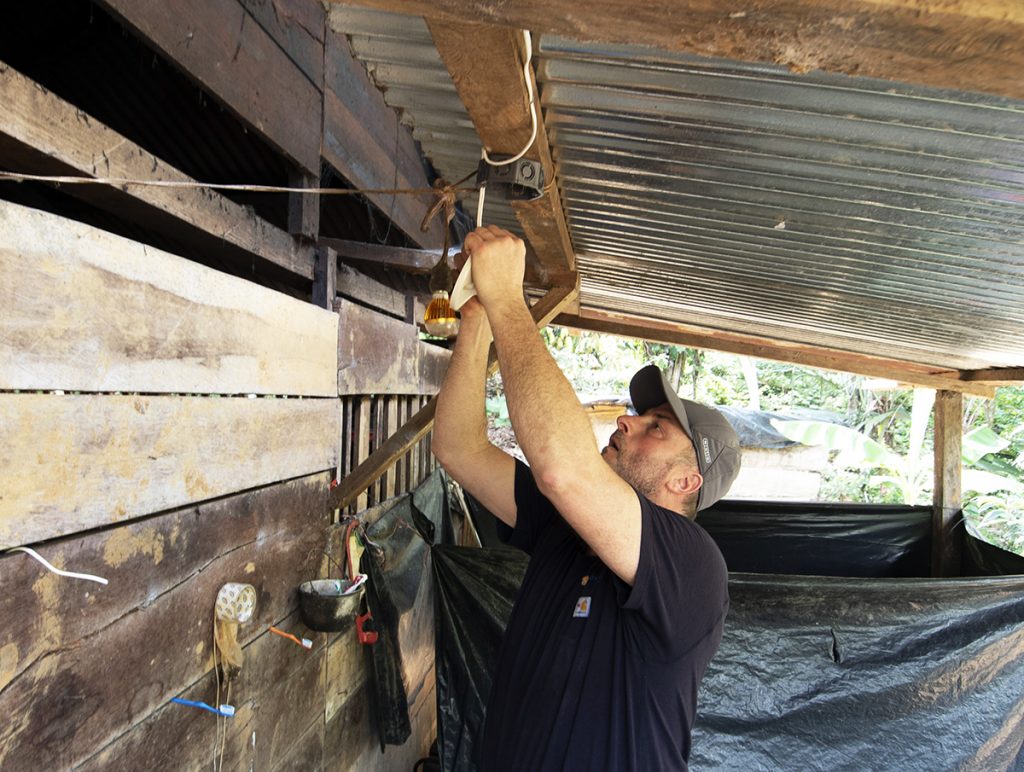The first day of better days ahead for rural Guatemalans

Aura Quib Cruz sat beside the chain link fence in her front yard that ran alongside the main gravel road through San Jacinto. In the shade of a large palm tree on the western edge of her yard, she shelled the kernels from ears of corn by hand into a large plastic tub. Empty cobs piled up at her feet.
To help ease the tedious mundane task that took hours, she set up her workstation there — as if to give herself a front row seat for a historic moment in the lives of her family and fellow villagers.
Across the road in the church yard, the village green for the tiny rural eastern Guatemalan community was bustling with activity. An electric line crew from the United States had arrived earlier that afternoon, and soon, much of Cruz’s life would begin to change for the better.
The crew, 14 Indiana electric cooperative linemen and four supervisors and support staff, along with four other Guatemalans hired by Project Indiana and a Guatemalan engineer from the National Rural Electric Cooperative Association, came to extend power lines some four miles to and through the village. They also wired some 90 homes, two churches and the village’s school campus.
Not only did the 30-year-old Cruz have a front row seat. Her home — shared with her husband, José; 11-year-old daughter, Dayli; and 2-year-old son, Jordan — was first to be wired.
The 2019 Project Indiana trip, which ran March 24-April 9, was the fourth and most recent for the non-profit organization formed by Indiana’s electric cooperatives. “Project Indiana: Empowering Global Communities for a Better Tomorrow,” in cooperation with National Electric Cooperative Association International, brings electricity to developing rural areas of Guatemala and provides the necessary knowhow the nascent utilities there need to sustain themselves and grow. By bringing electricity to rural communities in developing countries, Project Indiana provides the residents there better, healthier and fuller lives.
On this trip, the crew worked in the far northeast corner of the state (or “department”) of Alta Verapaz near its border with the department of Petén. The 2015 trip also worked in Alta Verapaz but farther to the south and west. Trips in 2012 and 2017 were in the northwestern mountainous regions of Guatemala near the southern Mexican border. Since Project Indiana put boots on the ground and up the poles and into the clouds, 70 Indiana lineworkers have now brought power to over 500 rural homes, four schools and five churches.
San Jacinto is a village of about 150 families tucked amid rolling hollows and perched along steep hillsides of knobby karst landscape. The villagers there live mostly through subsistence agriculture. They produce corn, beans, cardamom, chili, cacao (from where cocoa comes), bananas and other fruits, and raise chickens, pigs and cattle.
Watching and waiting

From her vantage point, Cruz would have seen the Indiana crew members open the doors of a barnlike warehouse on the edge of the church yard when they arrived. The barn was built to house the hardware and equipment the crew would need and serve as headquarters for the build.
Earlier in the day, José and Jordan had been among the large group of villagers gathered to peek inside at the transformers, giant spools of wire, insulators, ladders, meters and meter boxes, and other electric hardware that had been awaiting the arrival of the Hoosiers. Unlike the three previous trips, with San Jacinto, Project Indiana purchased the hardware and supplies in Guatemala, instead of having the heavy and bulky supplies expensively and slowly shipped from the United States.
All but five poles had been set, as well, ahead of the Hoosiers’ arrival. The 50 poles were set by locals and most all of the holes for the guy wire anchors were dug. Everything was done by hand.
First in line
Back across the road, José was finishing digging his own hole on the opposite side of the yard from where his wife sat with Dayli and Jordan, still shucking the corn for tortillas. He was getting ready to set the pole for his meter that would be needed the next morning. That’s when one group of the Project Indiana crew would begin individually wiring each home in preparation for when the power line overhead would be strung and dropped to his meter pole.
As Cruz sat, slowly fingering the ears, her smiling face couldn’t hide the fatigue setting in. She said it takes about 500 ears of corn to make about 100 tortillas, a staple for rural Guatemalans. She said she’ll shell that amount about twice a week. After shelling, she’ll then grind the corn into flour to bake into tortillas. While many in the village use diesel-powered motors to turn their grinders, Cruz said she still has to turn her grinder by hand. Through an interpreter, she smiled as she explained grinding takes about another hour each time and wears out both arms.
She said the first things the family plans to add once electricity arrives: an electric grinder and a refrigerator.
Toward dusk, with all the corn hulled, the meter pole set and the Project Indiana crew packing it in for the day, too, the entire Cruz family could relax. The four lined up across the seat of a small motorcycle — Jordan in front on the fuel tank, then dad at the controls, then Dayli, sandwiched between dad and mom, who was riding on the far back. And the four headed east down the road to visit friends. A new day would be dawning soon.
